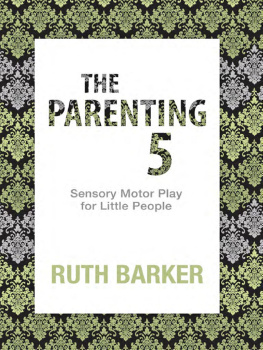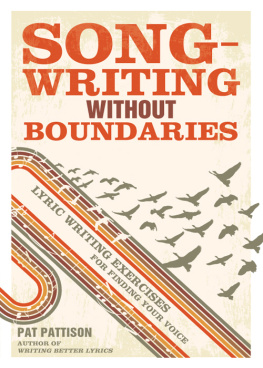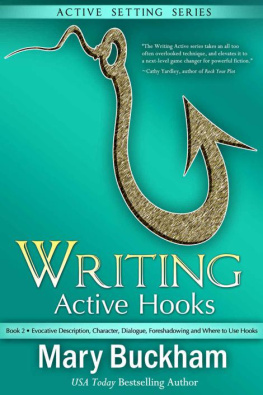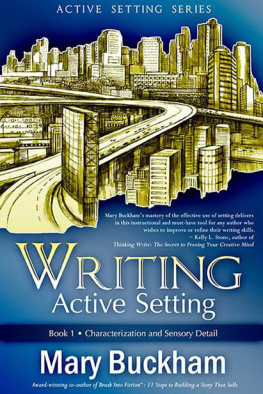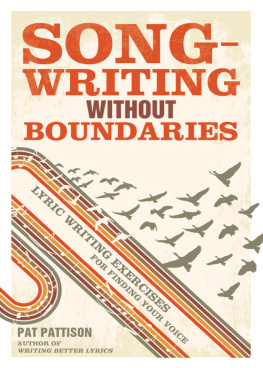Buckham - Writing Active Setting Book 1: Characterization and Sensory Detail
Here you can read online Buckham - Writing Active Setting Book 1: Characterization and Sensory Detail full text of the book (entire story) in english for free. Download pdf and epub, get meaning, cover and reviews about this ebook. year: 2012, publisher: Cantwell Publishing, LLC, genre: Detective and thriller. Description of the work, (preface) as well as reviews are available. Best literature library LitArk.com created for fans of good reading and offers a wide selection of genres:
Romance novel
Science fiction
Adventure
Detective
Science
History
Home and family
Prose
Art
Politics
Computer
Non-fiction
Religion
Business
Children
Humor
Choose a favorite category and find really read worthwhile books. Enjoy immersion in the world of imagination, feel the emotions of the characters or learn something new for yourself, make an fascinating discovery.
- Book:Writing Active Setting Book 1: Characterization and Sensory Detail
- Author:
- Publisher:Cantwell Publishing, LLC
- Genre:
- Year:2012
- Rating:3 / 5
- Favourites:Add to favourites
- Your mark:
- 60
- 1
- 2
- 3
- 4
- 5
Writing Active Setting Book 1: Characterization and Sensory Detail: summary, description and annotation
We offer to read an annotation, description, summary or preface (depends on what the author of the book "Writing Active Setting Book 1: Characterization and Sensory Detail" wrote himself). If you haven't found the necessary information about the book — write in the comments, we will try to find it.
Buckham: author's other books
Who wrote Writing Active Setting Book 1: Characterization and Sensory Detail? Find out the surname, the name of the author of the book and a list of all author's works by series.
Writing Active Setting Book 1: Characterization and Sensory Detail — read online for free the complete book (whole text) full work
Below is the text of the book, divided by pages. System saving the place of the last page read, allows you to conveniently read the book "Writing Active Setting Book 1: Characterization and Sensory Detail" online for free, without having to search again every time where you left off. Put a bookmark, and you can go to the page where you finished reading at any time.
Font size:
Interval:
Bookmark:
WRITING ACTIVE SETTING
BOOK 1: CHARACTERIZATION AND SENSORY DETAIL
Content copyright 2012 by Mary Arsenault Buckham.
All rights reserved.
Kindle Edition
First Edition
No part of this book may be reproduced or utilized in any form or by any means, electronic or mechanical, including photocopying, recording, or by any information storage and retrieval system without permission in writing from the publisher.
Published by
Cantwell Publishing LLC
2675 Wilson Street
Port Townsend , WA 98368
USA
ISBN: 978-1-939210-00-5
Cover Design: Hot Damn Designs
ACKNOWLEDGEMENTS
Writing any book does not happen in a vacuum, especially a How -To craft book. Id like to thank the hundreds and hundreds of writing students who helped define the assignments and the need to explore how to better use Setting in our novels. Id also like to thank my early readers, all writers who gave invaluable feedback on the format and content of this book: Laurie Adams, Kat Jorgensen, Elizabeth Gibson, Theresa Rogers, Ellen Russell and Laurel Wilczek. Any of your great advice I did not take was my fault alone. A special thanks to Dianna Love, writer extraordinaire and a good friend who has always been there for one last eagle-eyed look. Laurie Schnebly Campbell, co-founder with me of www.WriterUniv.com and a whiz with back cover blurbs. Kimberly Killion and her able assistant Jennifer Jakes of HOT DAMN Designs who really know how to design a killer cover and make the process painless. And to my husband, Jim Buckham, who makes all things possible in my world. And last, but not least, thanks to my readers. Without you, Id have no craft to teach. Thank you!
For the wr iters who want to expand their understanding of the craft of writing !
Note to Readers
Every effort has been made to cleanly edit the text. However, typos do slip in. If you find an error in the text, please email: so the issue can be corrected. I app reciate you as a reader and want to make sure you enjoy the reading and learning process. If you find errors, please bring them to my attention so I can continue to provide better books for all reader s .
Thank you!
Table of Contents
Overview
Ready to Start?
Anchoring the Reader
Subtext in Setting
Setting the Stage
Pacing and Setting
Assignment
Recap
Right Information/Right Signals
Revealing Character Through Setting
Assignment
Recap
Layering POV and Sensory Details
Ways to Bring Out Sensory Details
Assignment
Recap
Wrap Up
Bibliography
What Folks Are Saying About Active Setting
Part
INTRODUCTION
Setting is probably one of the most underu sed tools in a writers toolbox, but it doesnt have to be.
Settings involve so much more than stringing together a list of adjectives or dumping a chunk of visual clues to orient the reader. Setting can create the world of your story, show characterization, add conflict, slow or speed up your pacing, add or decrease tension, relate a characters back story, thread in emotion , and more. Some authors are known for creating Settings that are so deeply integrated into the scene that when reader s step away from reading they still find themselves in the place described on the page.
Think of Setting as the stage which contains your story, and it should be as important as any character whether you choose to write sparse ly or in great detail. The setting orients the readers to the geography, climate, social context, time of the story s events, foreshadowing of unfolding events , architecture , and much more. When handled well the Setting can also impact the thoughts of your readers and actions of your characters and thus move the story forward .
I f not handled well, poor Setting description can thwart or frustrate the reader to the point where they want to throw away the story or actually do put your book down and walk away .
Setting can add so much to your story wor ld or it can add nothing. When creating Active Setting were looking to add subtext in your writing, a deeper way for your reader to experience your story. Instead of simply describing a place or thing for the sake of description, well look closely at how to maximize what you are showing the reader . Youll learn how to verbally illustrate a place and where to insert this information so the reader will understand the intention of your scenes and be pulled deeper into the story. Specifically in Book 1 , well be looking at using Setting to reveal your characters and to add sensory details .
Well make sure you do not focus your reader on something that isnt pertinent to your story.
Note: The details of your Setting must matter to your story.
Example youre showing the reader a room in a house. That room and the details in that room should show characterization or conflict or emotion or foreshadowing or be there for a reason instead of simply describing placement of objects in space.
In Book 1 , lets examine Setting in two vital ways: to show Characterization and to add Sensory details . But first an overview of what Setting is and what it can be .
OVERVIEW
In this book well focus on keeping in mind three key elements in crafting Setting :
(1) You need to create the world of your story .
(2) Each character in your story experiences the story world differently .
(3) Your story world involves more than one sense.
What this means is that your role as a writer is to create the world of your story so that the reader not only sees it but experiences every detail . Regardless if youre writing about a famous place that millions have lived in or experienced, your Characters perceptions of that world are what matters in your story. Youre not writing about any living room, any small town, any large city; you are writing about a specific living room, a specific small town , a specific large city a nd why those things matter to your character.
Pull the reader deeper into your story by allowing them to experience the Setting on a deeper level. It can be the difference between standing on a beach facing the Pacific Ocean , feeling the sand beneath your bare toes, inhaling the s c ent of tangy salt spray, hearing the roar and slam of the waves versus looking at a postcard.
Learning to write Active Setting is as easy as knowing when and where you want to ramp up your Setting details and why.
Ive had the privilege to work with thousands of writers in all genres over the years and to see them take the blah or non-existent Setting of their stories and make it work harder. Thats my wish for every writer who takes the time to study Active Setting .
READY TO START ?
Throughout this book well be looking at how you can ramp up elements of your story by how you use or do not use your Setting . In this book w ell take an overview of why Setting matters to a story and see examples from published authors showing you in a variety of genres how they maximized Setting in their novels. Setting is more than describing a place.
Note: Active Setting means using your Setting details to work harder and smarter.
First , I want you to focus in on what seems like a basic assumption :
Your reader has never been in your world wherever your world is.
I dont care if its New York City and most of your readers live in Manhattan ; your reader has never been in your world. T he Setting and world youll be painting on the page are more than a travelogue or a list of street names.
Not everything that a character sees , smells , tastes , or touches need end up in your final manuscript , but its a place to start. For example, a POV [point of view of the person whose thoughts, emotions, background , and world view the reader is experiencing the story through] character that is miserable in a school environment will not see or notice the same items as a POV character who finds school a sanctuary and the center of their world.
Next pageFont size:
Interval:
Bookmark:
Similar books «Writing Active Setting Book 1: Characterization and Sensory Detail»
Look at similar books to Writing Active Setting Book 1: Characterization and Sensory Detail. We have selected literature similar in name and meaning in the hope of providing readers with more options to find new, interesting, not yet read works.
Discussion, reviews of the book Writing Active Setting Book 1: Characterization and Sensory Detail and just readers' own opinions. Leave your comments, write what you think about the work, its meaning or the main characters. Specify what exactly you liked and what you didn't like, and why you think so.




